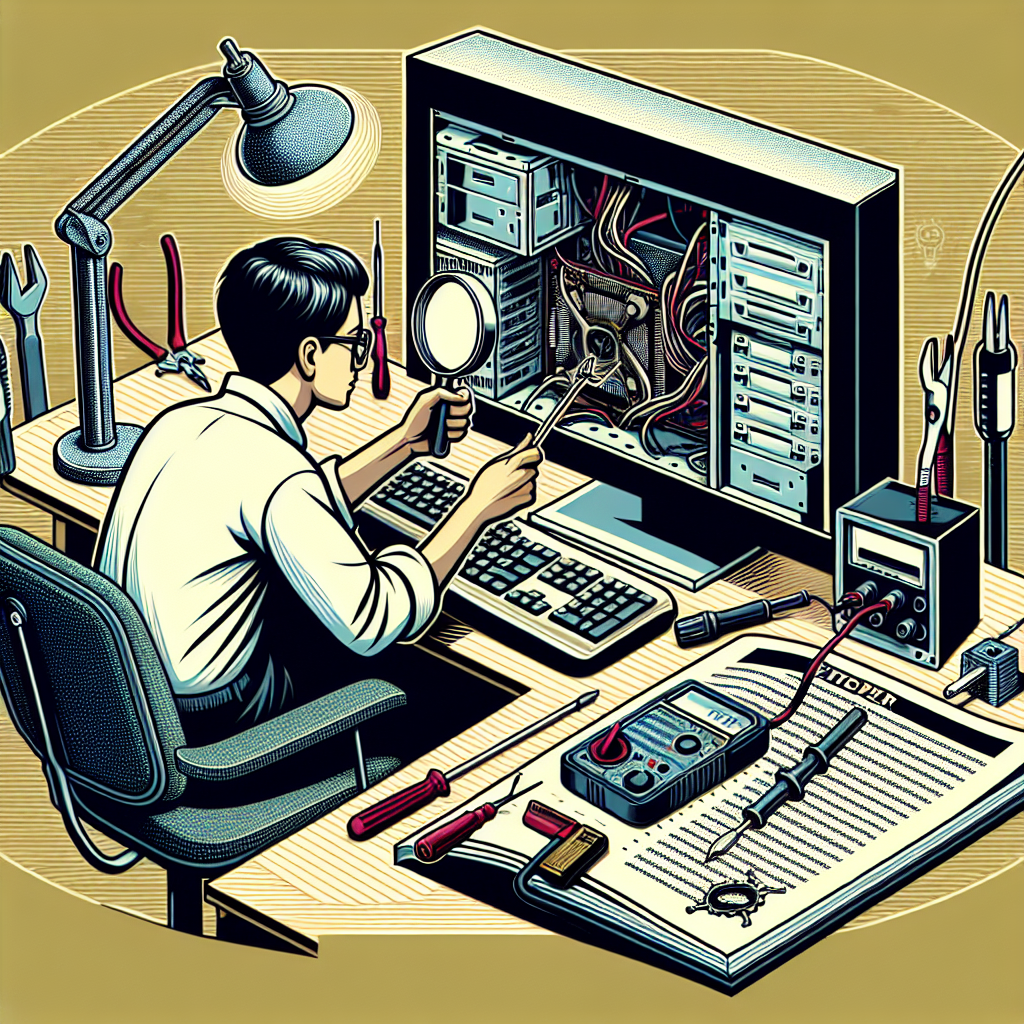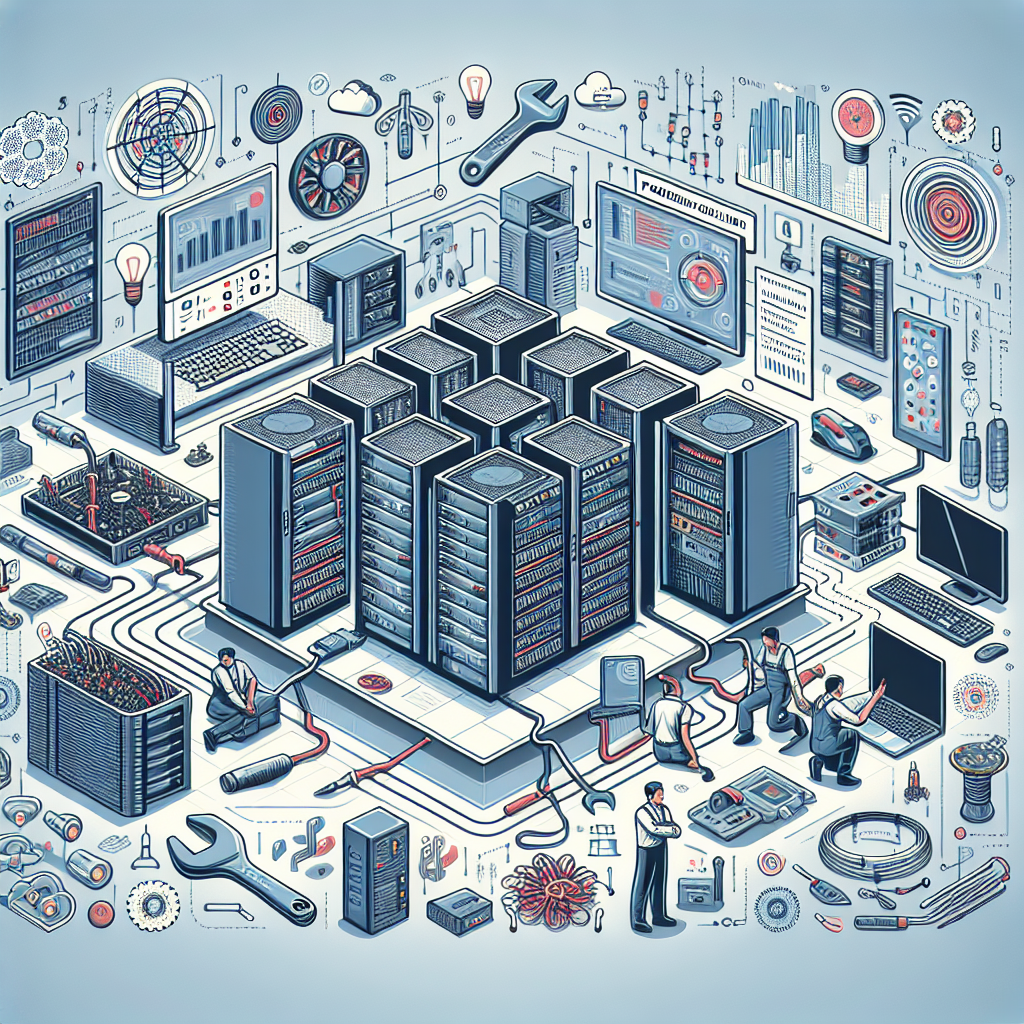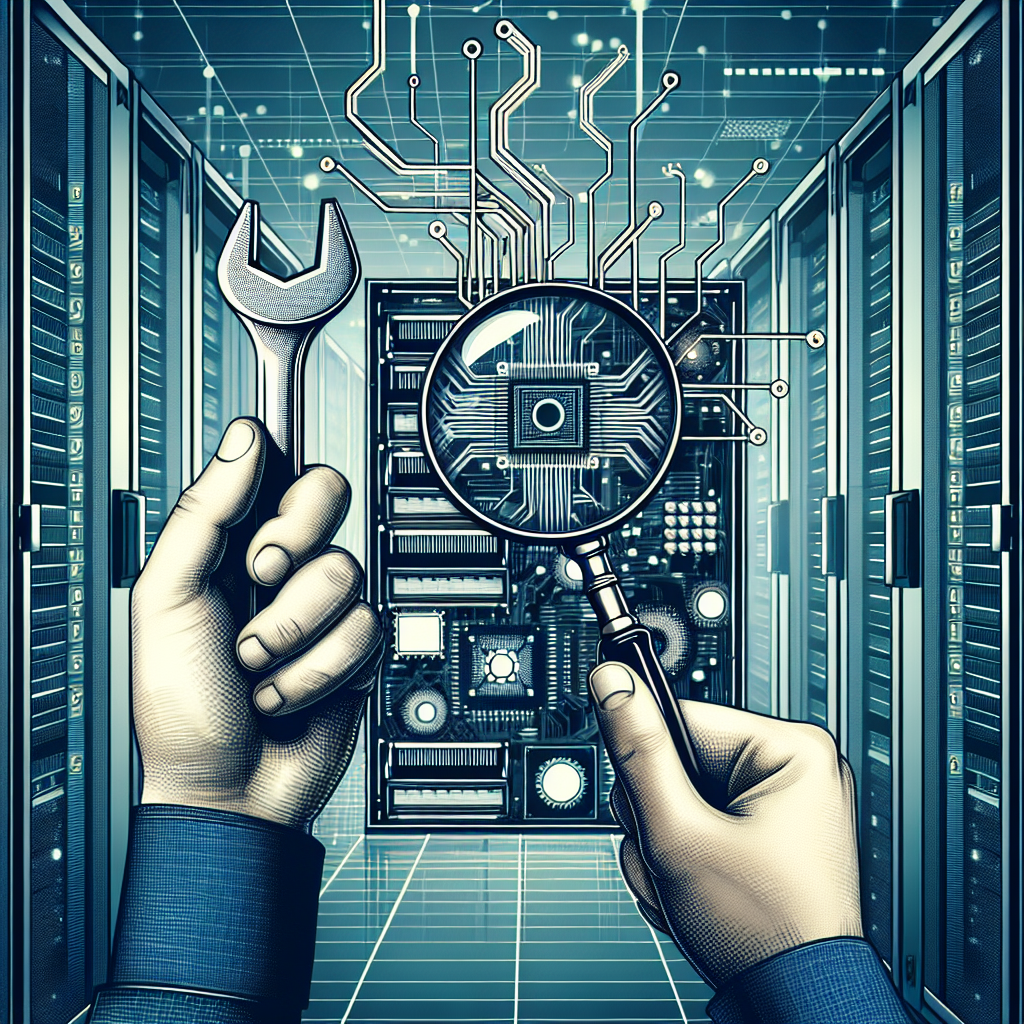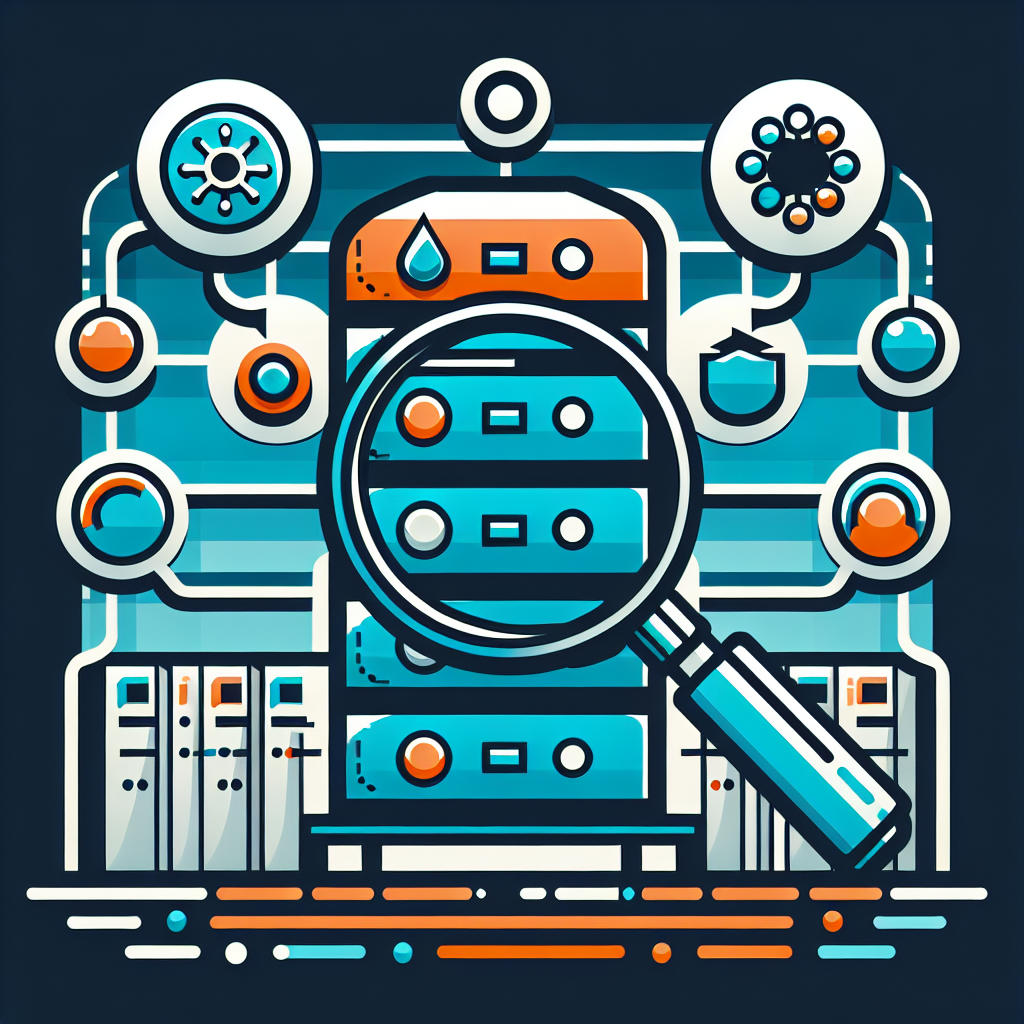Your cart is currently empty!
Tag: Resolving

Troubleshooting 101: A Guide to Resolving Technical Issues
Troubleshooting 101: A Guide to Resolving Technical IssuesTechnical issues are a common occurrence in today’s digital world. Whether you’re dealing with a malfunctioning computer, a glitchy smartphone, or a faulty internet connection, troubleshooting skills are essential for resolving these problems quickly and effectively. In this guide, we’ll walk you through the basic steps of troubleshooting to help you tackle any technical issue that comes your way.
Step 1: Identify the Problem
The first step in troubleshooting is to identify the problem. Take note of any error messages, unusual behavior, or other symptoms that are occurring. This will help you narrow down the possible causes of the issue and determine the best course of action.
Step 2: Gather Information
Once you’ve identified the problem, gather as much information as possible about the device or system that is experiencing the issue. This may include the make and model of the device, the operating system it’s running on, and any recent changes or updates that have been made.
Step 3: Check for Common Causes
Next, check for common causes of the issue. This may include checking for software updates, ensuring that all cables and connections are secure, or checking for any hardware malfunctions. By ruling out these common causes, you can narrow down the possible reasons for the problem.
Step 4: Try Basic Troubleshooting Steps
If you’re still experiencing technical issues after checking for common causes, try some basic troubleshooting steps. This may include restarting the device, running a virus scan, clearing the cache or cookies, or checking for software conflicts. Sometimes, simple fixes like these can resolve the issue quickly.
Step 5: Research Solutions
If basic troubleshooting steps don’t resolve the issue, it’s time to do some research. Look up the specific error message or symptoms you’re experiencing online to see if others have encountered similar issues and found solutions. You may also want to consult the device’s user manual or contact technical support for further assistance.
Step 6: Seek Professional Help
If you’re still unable to resolve the technical issue on your own, it may be time to seek professional help. Contact the manufacturer of the device, a local repair shop, or a tech-savvy friend or family member for assistance. Sometimes, a professional touch is needed to diagnose and fix more complex technical issues.
By following these troubleshooting steps, you can tackle any technical issue that comes your way with confidence. Remember to stay patient, thorough, and methodical in your approach, and don’t be afraid to ask for help when needed. With a little persistence and problem-solving skills, you’ll be able to resolve even the trickiest technical issues in no time.

Effective Strategies for Resolving Data Center Problems
Data centers are crucial for the functioning of businesses in the digital age. They house servers, storage devices, networking equipment, and other critical hardware that store and process data. However, data center problems can occur, leading to downtime, data loss, and other issues that can have serious consequences for a company. It is essential for organizations to have effective strategies in place to resolve data center problems quickly and efficiently.One of the most common data center problems is network issues. This can include slow network speeds, connectivity problems, and security breaches. To resolve network issues, organizations should have a robust monitoring system in place that can detect and alert IT staff to potential problems before they escalate. Regular network audits and security assessments can also help identify vulnerabilities and prevent potential breaches.
Another common data center problem is hardware failure. This can include server crashes, storage device malfunctions, and power outages. To address hardware failures, organizations should have redundancy in place, such as backup servers and storage devices, to ensure continuity of operations in case of a hardware failure. Regular maintenance and monitoring of hardware can also help prevent failures before they occur.
Data loss is another significant data center problem that can have severe consequences for a business. To prevent data loss, organizations should have regular data backups in place, both onsite and offsite. This ensures that data can be restored quickly in case of accidental deletion, corruption, or other issues. Data encryption and access control measures can also help protect sensitive data from unauthorized access or theft.
In addition to technical issues, human error can also cause data center problems. This can include accidental deletion of data, misconfiguration of hardware or software, and other mistakes that can lead to downtime and data loss. To address human error, organizations should invest in training and education for IT staff to ensure they have the necessary skills and knowledge to manage and maintain the data center effectively. Implementing strict change management processes and access controls can also help prevent unauthorized changes that can lead to problems.
Overall, having effective strategies in place for resolving data center problems is essential for organizations to ensure the continuity of operations and protect their data. By implementing robust monitoring systems, redundancy measures, data backups, and training programs, organizations can minimize the impact of data center problems and ensure that their data center remains secure and operational.

Strategies for Resolving Data Center Issues: A Problem Management Approach
Data centers are the heart of any organization’s IT infrastructure, housing critical data and applications that are essential for business operations. However, even the most well-designed data center can experience issues that can disrupt operations and impact the overall performance of the organization. In order to effectively manage and resolve data center issues, a problem management approach is essential.Problem management is a proactive approach to identifying and addressing the root causes of recurring incidents within the data center environment. By implementing a problem management strategy, organizations can reduce the frequency and impact of data center issues, leading to improved reliability and performance.
There are several key strategies that organizations can employ to effectively resolve data center issues using a problem management approach:
1. Incident Identification and Recording: The first step in resolving data center issues is to accurately identify and record incidents as they occur. This involves creating a centralized system for tracking incidents, including details such as the date and time of the incident, the affected systems or applications, and the impact on business operations.
2. Root Cause Analysis: Once an incident has been identified, it is important to conduct a thorough root cause analysis to determine the underlying factors that led to the issue. This may involve reviewing system logs, analyzing performance data, and conducting interviews with staff members to gather additional information.
3. Problem Prioritization: Not all data center issues are created equal, and it is important to prioritize problems based on their impact on business operations. By assigning priority levels to problems, organizations can focus their resources on resolving the most critical issues first.
4. Problem Resolution: Once the root cause of an issue has been identified and prioritized, it is important to develop and implement a plan for resolving the problem. This may involve implementing software patches, upgrading hardware, or making changes to system configurations.
5. Continuous Improvement: Problem management is an ongoing process, and organizations should continuously monitor and review their data center operations to identify and address potential issues before they escalate. By regularly reviewing incident data and performance metrics, organizations can proactively identify areas for improvement and implement preventative measures to mitigate future issues.
By implementing a problem management approach to resolving data center issues, organizations can improve the reliability and performance of their IT infrastructure, leading to increased efficiency and reduced downtime. By accurately identifying and addressing the root causes of data center issues, organizations can minimize the impact on business operations and ensure the continued success of their IT environment.

Effective Techniques for Resolving Data Center Problems Quickly
Data centers are critical components of any organization’s IT infrastructure, housing servers, storage devices, and networking equipment that support the organization’s day-to-day operations. However, data center problems can arise unexpectedly, causing downtime and disruptions that can impact business operations. In order to minimize the impact of data center problems, IT professionals must be equipped with effective techniques for resolving these issues quickly and efficiently.One of the most important techniques for resolving data center problems quickly is to establish a comprehensive monitoring and alerting system. By monitoring key performance metrics such as server CPU usage, network bandwidth, and storage capacity, IT professionals can proactively identify potential issues before they escalate into major problems. Additionally, alerting systems can notify IT staff of any abnormalities or deviations from normal performance, allowing them to quickly investigate and address the issue.
Another important technique for resolving data center problems quickly is to maintain accurate documentation of the data center environment. This includes keeping up-to-date inventories of hardware and software components, as well as detailed network diagrams and configuration settings. Having this information readily available can help IT professionals quickly identify the root cause of a problem and implement a solution, reducing downtime and minimizing the impact on business operations.
In addition to monitoring and documentation, IT professionals should also implement regular maintenance and testing procedures to proactively identify and address potential issues. This includes performing routine hardware and software updates, conducting regular backups of critical data, and testing disaster recovery plans to ensure they are effective in the event of a data center failure.
When a data center problem does occur, IT professionals should follow a systematic troubleshooting process to quickly identify and resolve the issue. This process typically involves isolating the problem to a specific component or system, gathering relevant information such as error logs and performance metrics, and testing potential solutions to determine the most effective course of action.
In some cases, IT professionals may need to escalate the issue to vendor support or engage with external experts to help resolve the problem. By working collaboratively with external partners, IT professionals can leverage their expertise and resources to quickly address complex data center issues and minimize downtime.
Overall, effective data center problem resolution requires a combination of proactive monitoring, documentation, maintenance, and troubleshooting techniques. By implementing these strategies, IT professionals can quickly identify and resolve data center problems, minimizing disruptions to business operations and ensuring the reliability and availability of critical IT systems.

Data Center Troubleshooting: Tips for Resolving Performance Issues
Data centers are the heart of any organization’s IT infrastructure, serving as the central hub for storing, processing, and managing data. However, like any complex system, data centers are prone to performance issues that can disrupt operations and impact business productivity. In this article, we will discuss some tips for resolving performance issues in data centers.1. Monitor Performance Metrics: The first step in troubleshooting data center performance issues is to monitor key performance metrics such as CPU usage, memory utilization, disk I/O, network traffic, and application response times. By regularly monitoring these metrics, you can quickly identify any anomalies or bottlenecks that may be affecting performance.
2. Identify the Root Cause: Once you have identified performance issues, it is important to determine the root cause of the problem. This may involve analyzing logs, conducting performance tests, or using monitoring tools to pinpoint the source of the issue. Common causes of performance issues in data centers include hardware failures, network congestion, software bugs, and misconfigured settings.
3. Optimize Hardware and Software: To improve data center performance, it is essential to optimize both hardware and software components. This may involve upgrading hardware components such as servers, storage devices, and networking equipment to improve capacity and performance. Additionally, optimizing software configurations, updating drivers, and applying patches can help resolve performance issues caused by software bugs or misconfigurations.
4. Implement Load Balancing: Load balancing is a technique used to distribute network traffic evenly across multiple servers to prevent overloading and improve performance. By implementing load balancing mechanisms, you can ensure that workloads are distributed efficiently and prevent any single server from becoming a bottleneck.
5. Scale Out or Scale Up: If performance issues persist despite optimization efforts, you may need to consider scaling out or scaling up your data center infrastructure. Scaling out involves adding more servers or storage devices to increase capacity and distribute workloads, while scaling up involves upgrading existing hardware components to improve performance. By scaling out or scaling up, you can accommodate growing workloads and ensure optimal performance.
6. Conduct Regular Maintenance: To prevent performance issues from occurring in the future, it is important to conduct regular maintenance and monitoring of your data center infrastructure. This may involve performing routine hardware inspections, updating software components, and implementing best practices for data center management. By proactively addressing potential issues, you can minimize downtime and ensure optimal performance.
In conclusion, resolving performance issues in data centers requires a combination of monitoring, troubleshooting, optimization, and maintenance efforts. By following these tips, you can identify and resolve performance issues quickly and effectively, ensuring that your data center operates at peak performance levels.

Effective Strategies for Resolving Data Center Outages and Downtime
Data center outages and downtime can have a significant impact on businesses, leading to lost revenue, decreased productivity, and damage to reputation. Therefore, it is crucial for organizations to have effective strategies in place to resolve these issues quickly and minimize the impact on their operations.One of the key strategies for resolving data center outages and downtime is to have a comprehensive disaster recovery plan in place. This plan should outline the steps to be taken in the event of an outage, including how to quickly identify the cause of the issue, restore services, and communicate with stakeholders. Regular testing and updating of the disaster recovery plan is also essential to ensure that it remains effective and relevant to the organization’s needs.
Another important strategy for resolving data center outages is to have redundant systems in place. This means having backup servers, storage devices, and network connections that can quickly take over in the event of a failure. Redundant systems can help to minimize downtime and ensure that critical services remain operational in the event of an outage.
Monitoring and proactive maintenance are also key strategies for resolving data center outages and downtime. By regularly monitoring the performance of hardware and software systems, organizations can identify potential issues before they escalate into full-blown outages. Proactive maintenance, such as applying software patches and updates, can help to prevent outages caused by known vulnerabilities.
In addition to these strategies, it is also important for organizations to have a skilled and experienced IT team in place to quickly respond to data center outages. This team should have the expertise to troubleshoot and resolve issues quickly, minimizing the impact on the organization’s operations.
Finally, communication is essential during a data center outage. Organizations should have a clear communication plan in place to keep stakeholders informed about the status of the outage, the steps being taken to resolve it, and the expected timeline for restoration of services. Transparent and timely communication can help to mitigate the impact of an outage on the organization’s reputation and customer relationships.
In conclusion, data center outages and downtime can have serious consequences for businesses, but with effective strategies in place, organizations can minimize the impact of these issues and quickly restore services. By implementing a comprehensive disaster recovery plan, investing in redundant systems, monitoring and maintaining systems proactively, and having a skilled IT team in place, organizations can be better prepared to resolve data center outages and downtime quickly and effectively.

Resolving Data Center Challenges: A Comprehensive Approach to Problem Management
In today’s fast-paced and technology-driven world, data centers play a crucial role in ensuring that businesses can operate efficiently and effectively. However, managing a data center comes with its own set of challenges, ranging from hardware failures to software glitches to security breaches. To ensure the smooth operation of a data center, it is essential to have a comprehensive approach to problem management.One of the key challenges that data centers face is downtime. Downtime can be caused by a variety of factors, including hardware failures, software bugs, power outages, and security breaches. To minimize downtime, data center managers need to have a proactive approach to problem management. This includes regularly monitoring the health of the data center’s hardware and software, as well as implementing backup and recovery strategies to ensure that data can be quickly restored in the event of a failure.
Another challenge that data centers face is security breaches. With the increasing threat of cyber attacks, data center managers need to be vigilant in protecting their data from unauthorized access. This includes implementing robust security measures, such as firewalls, encryption, and access controls, as well as regularly monitoring the data center for any signs of suspicious activity.
In addition to downtime and security breaches, data center managers also need to address other challenges, such as scalability, energy efficiency, and compliance. Scalability is important for data centers to be able to accommodate the growing needs of businesses, while energy efficiency is crucial for reducing operating costs and minimizing the environmental impact of the data center. Compliance with industry regulations and standards is also essential to ensure that the data center is operating in a legal and ethical manner.
To effectively address these challenges, data center managers need to take a comprehensive approach to problem management. This includes identifying potential issues before they escalate into major problems, implementing proactive monitoring and maintenance strategies, and developing robust contingency plans to address any issues that may arise. By taking a proactive and comprehensive approach to problem management, data center managers can ensure the smooth operation of their data center and minimize the risk of downtime, security breaches, and other issues that can impact the business.
In conclusion, managing a data center comes with its own set of challenges, but with a comprehensive approach to problem management, these challenges can be effectively addressed. By proactively monitoring and maintaining the data center, implementing robust security measures, and addressing issues such as scalability, energy efficiency, and compliance, data center managers can ensure the smooth operation of their data center and provide the foundation for a successful business.

Resolving Data Center Problems: Tips and Tricks for IT Professionals
Data centers are the heart of any organization’s IT infrastructure, housing the servers, storage, and networking equipment that keep businesses running smoothly. However, like any complex system, data centers can experience problems that can disrupt operations and cause headaches for IT professionals. In this article, we will discuss some tips and tricks for resolving data center problems quickly and effectively.1. Monitoring and Maintenance
One of the most important steps in preventing data center problems is to regularly monitor and maintain the equipment. IT professionals should use monitoring tools to keep track of server performance, network traffic, and storage capacity. By staying proactive and addressing issues before they escalate, IT professionals can prevent downtime and ensure the smooth operation of the data center.
2. Identifying the Root Cause
When a problem does arise in the data center, it is crucial to identify the root cause quickly. This may involve troubleshooting hardware failures, network issues, or software glitches. IT professionals should use diagnostic tools and techniques to pinpoint the source of the problem and develop a plan for resolution.
3. Implementing Redundancy
To minimize the impact of hardware failures or network outages, IT professionals should implement redundancy in the data center. This may involve using redundant power supplies, network connections, or storage arrays to ensure that critical systems remain operational even in the event of a failure. By having backup systems in place, IT professionals can reduce downtime and keep the data center running smoothly.
4. Disaster Recovery Planning
In addition to redundancy, IT professionals should also have a comprehensive disaster recovery plan in place. This plan should outline the steps to take in the event of a major outage or disaster, including how to restore data and services quickly. By having a well-thought-out disaster recovery plan, IT professionals can minimize the impact of disruptions and ensure business continuity.
5. Training and Documentation
Finally, IT professionals should invest in training and documentation to ensure that staff members are well-equipped to handle data center problems. By providing ongoing training and maintaining detailed documentation of systems and procedures, IT professionals can empower their teams to quickly resolve issues and keep the data center running smoothly.
In conclusion, resolving data center problems requires a combination of monitoring, maintenance, troubleshooting, and planning. By following these tips and tricks, IT professionals can proactively address issues, minimize downtime, and ensure the smooth operation of their organization’s data center.


